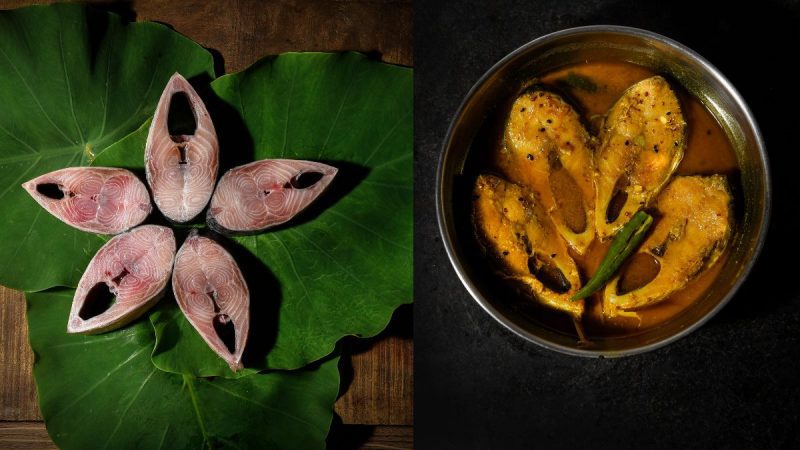Hilsa fish has long been celebrated for its unique flavour, cultural significance, and economic value. It’s the fish that once held a remarkable and widespread prominence across the Indian subcontinent. Ilish Maach (Hilsa fish) is now perhaps just available in Bengal, Bangladesh and Burma.
Monsoon Maane Ilish Maach
The monsoon season brings with it a host of culinary delights, and for many, it is synonymous with the arrival of Hilsa fish. The rainy season’s influence on the fish’s behaviour enhances its taste. During these months, Hilsa is considered at its finest–with a rich, buttery texture and a subtle, complex taste that sets it apart from other fish. The abundance of Hilsa during this period makes it a centrepiece of many traditional meals.
In Bengal, monsoon is synonymous with Hilsa. “Having moved out of my hometown (Kolkata) 9 years ago, my earliest memories of having Hilsa/Ilish maach’er jhol is of my mom feeding me. That is the purest emotion right there. When I was young, I struggled a lot to have Hilsa on my own. It is notoriously known for its bones. My mother used to meticulously comb through, make a ball out of fish meat and then mash it in rice with the gravy and feed me,” Rachna Srivastava, managing editor of Curly Tales India & ME, fondly remembers.
The fish is an integral part of festivals and rituals that coincide with the monsoon season. Offered in ceremonies, the fish is often prepared in classic dishes like Shorshe Ilish, Ilish Bhapa, Ilish Pulao and more.
Bengal’s association with Hilsa can be traced back to the fish’s abundance in the region and local culinary practices. The British Raj’s influence in Bengal further amplified Hilsa’s prominence. They popularised boneless smoked Hilsa, catering to European palates. It’s true that Bengal’s rivers and estuaries, particularly the Ganges remain some of the last refuges for this migratory fish. As Hilsa populations continue to decline elsewhere, Bengal has become a critical guardian of this culinary and cultural treasure.
However, the current dynamics surrounding its custodianship involve a complex interplay of historical, cultural, and ecological factors. But, was it always like that?
A Cultural Symbol All Over
There’s a reason why Bengal may seem like the custodian of Hilsa. It is one of the few remaining regions where the fish is still found in significant numbers. However, this wasn’t the case before.
The fish’s migratory patterns from the Arabian Sea and the Bay of Bengal into various rivers created a natural cycle that communities along these waterways eagerly anticipated. Historically, Hilsa fish has enjoyed a prominent status dating back centuries. Its presence in ancient texts and folklore underscores its long-standing importance. Hilsa, or Tenualosa ilisha, is mentioned in classical literature, such as the 12th-century Sanskrit text, Manasollasa. The ancient text describes the fish as a delicacy fit for royalty.
Its popularity continued through the Mughal era. Hilsa enamoured the Mughal emperors. Stories from this era tell of emperors eagerly awaiting the arrival of these silver and vermillion-tinted fish as they made their way up the rivers during the monsoon season. The Mughal kitchens would prepare lavish feasts centred around Hilsa, elevating the fish to a royal delicacy. “Even now, Ilish enjoys the same gusto. Thanks to so many Ilish Festivals or Hilsa Food Festivals across the country, the joyousness of savouring the famed fish is shared by many,” she adds.
In Southern India, it has various names such as ulasa in Tamil Nadu, paliya in Karnataka, and pulasa in the Godavari delta. Pulasa in the Godavari delta, holds a special place in the local cuisine. The famous dish pulasa pulusu is a rich, red, fiery curry, slow-cooked for several hours. Oriyas make Ilisha Besara, hilsa cooked in mustard and curd-based sauce.
Bengal’s Enthusiasm For Hilsa
The notion of Ilish mafia in Bengal reflects a passionate dedication to preserving and promoting Hilsa. It’s not a term to blame or criticise. Rather, it is to acknowledge the fervour with which Bengalis embrace and celebrate the fish. The cultural ownership of Hilsa stems from a deep-seated pride in the region’s culinary heritage; and an understanding of the fish’s importance in Bengali identity.
Rachna shares a heartfelt anecdote about how Hilsa fish transcends being just a meal; it embodies a deep family emotion.”I once attempted to have it on my own after moving out of my hometown. But the struggle seemed far less. I knew how to have it, I knew how to sift through and navigate through its deboning ordeal, and devour the delicacy in front of me. Yet, what I missed most was my mom’s special touch.”
The global promotion of Hilsa dishes and the region’s culinary innovations have helped elevate the fish’s status internationally. While the perception of exclusivity may stem from Bengal’s status as a last bastion, it is ultimately the region’s commitment to preserving and celebrating the fish. While Bengal’s role is significant here, it also faces challenges and opportunities to sustain the Ilish populations. “Growing up I have seen a lot of my Bengali friends (to date) revere Ilish maach. It is an integral part of the culture. While Hilsa season is limited and the fish itself is not available as abundantly as it used to, the reverence is undeterred,” she shares with hope.
The story of Hilsa is one of historical grandeur and contemporary challenges. Once revered as the king of fish, Hilsa’s journey needs a saving!
Also Read: From Salim Sulaiman Live To Ilish Utsav, 7 Best Events In Kolkata This August
Cover image credits: Canva

